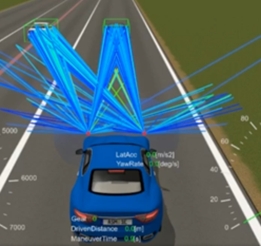MSc thesis project proposal
[TUD-NXP] Fusion of mono-static and bi-static radar responses (01.12.2022)
Project outside the university
NXPIn this assignment, the student will work on Direction-of-Arrival estimation techniques that use measurement data obtained from multiple radars distributed on the car’s fascia. Such a system could result in an increased target separation in the direction of the arrival dimension whilst keeping the physical dimensions of the individual radars small. For coherent operation synchronization in time, frequency and phase are needed. The quasi-coherent operation doesn’t require phase coherency. The measurement data obtained from multiple radars can be grouped into mono-static and bi-static responses. Depending on the system coherency and target coherency this data can be processed in a coherent way, a non-coherent way, or a mix of coherent and non-coherent processing. The best target separation is obtained with fully coherent processing. Sparsity-based algorithms for DoA estimation, like SBL and FOCUSS, are gaining interest. These algorithms assume that the multi-antenna response as measured by the radar is caused by a small number of targets. In an iterative way, the measured response is matched with a sparse collection of sources. Multiple Measurement Vectors technique in relation to sparsity-based DoA algorithms usually refers to time-sequential measurements with an individual radar system. With the distributed radar architecture as mentioned before, the collection of mono-static and bi-static responses can be regarded as multiple measurements with slightly different perceptions of the radar scene. The underlying sparsity of targets for the multiple measurements can have a high correlation for a coherent target scene, but for a non-coherent radar scene a target might be not seen by all individual radar sensor
Assignment
The assignment involves the following components:
- After Range Doppler processing extract measurement data for DoA estimation from the mono-static and bi-static responses. This involves associating data from different range Doppler cells because a target can be experienced at a different distance and with a different velocity by the individual radar sensors.
- Carry out simulations with sparsity-based DoA algorithms using multiple measurement vectors.
- Quantify the difference in DoA performance between full-coherent and quasi-coherent operations.
- Investigate how DoA performance scales with the number of measurements.
- DoA performance can be determined in terms of target separation and/or target detection probability. As a function of the sparsity correlation between measurements, these DoA performance indicators should be investigated.
Requirements
This project requires a self-motivated candidate with a strong background in optimization, statistical signal processing, array signal processing, estimation theory, and some familiarity with radio frequency (RF) and radar concepts. The ideal candidate feels challenged by both theoretical and practical problems.
- Literature survey of the current state-of-the-art on sparsity-based DoA estimation technique with the use of multiple measurement vectors
- Selection of the most promising techniques
- System modeling and algorithm development in MATLAB.
- Measurement collection, algorithm validation, and performance evaluation.
- Report and documentation at NXP Semiconductor.
- (optional) Submit a conference paper and file a patent.
Contact
prof.dr. Olexander Yarovoy
Microwave Sensing, Signals and Systems Group
Department of Microelectronics
Last modified: 2025-02-11
